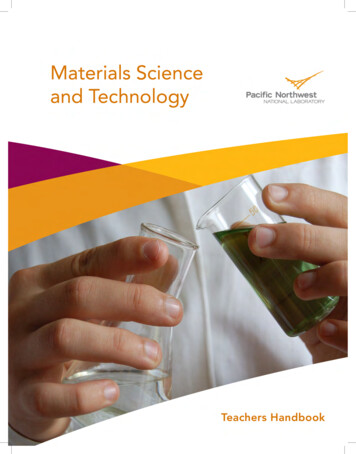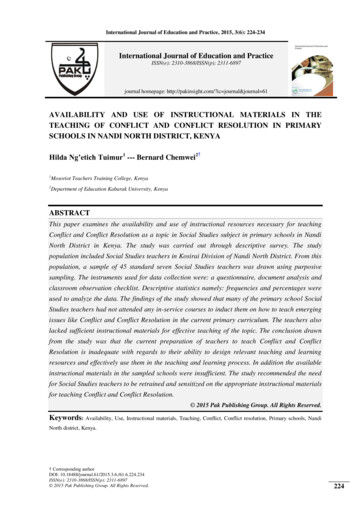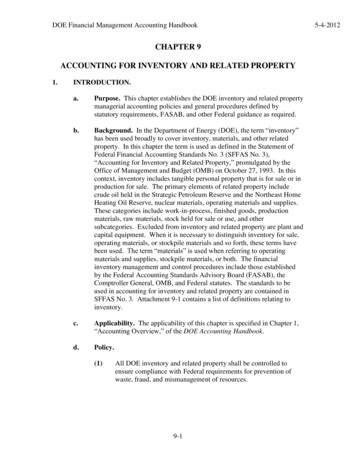
Transcription
DISCLAIMERThis report was prepared as an account of work sponsored by an agency of theUnited States Government. Neither the United States Government nor any agencythereof, nor Battelle Memorial Institute, nor any of their employees, makes anywarranty, express or implied, or assumes any legal liability or responsibilityfor the accuracy, completeness, or usefulness of any information, apparatus,product, or process disclosed, or represents that its use would not infringeprivately owned rights. Reference herein to any specific commercial product,process, or service by trade name, trademark, manufacturer, or otherwise does notnecessarily constitute or imply its endorsement, recommendation, or favoring bythe United States Government or any agency thereof, or Battelle MemorialInstitute. The views and opinions of authors expressed herein do not necessarilystate or reflect those of the United States Government or any agency thereof.PACIFIC NORTHWEST NATIONAL LABORATORYoperated byBATTELLEfor theUNITED STATES DEPARTMENT OF ENERGYunder Contract DE-AC05-76RL01830Printed in the United States of AmericaAvailable to DOE and DOE contractors from theOffice of Scientific and Technical Information,P.O. Box 62, Oak Ridge, TN 37831-0062;ph: (865) 576-8401fax: (865) 576-5728email: reports@adonis.osti.govAvailable to the public from the National Technical Information Service,U.S. Department of Commerce, 5285 Port Royal Rd., Springfield, VA 22161ph: (800) 553-6847fax: (703) 605-6900email: orders@ntis.fedworld.govonline ordering: http://www.ntis.gov/ordering.htmThis document was printed on recycled paper.(9/2003)
PNNL-17764Materials Science and TechnologyTeachers HandbookPacific Northwest National LaboratoryRichland, WashingtonPublished in 1994, cleared for release in 2008
PNNL-17764Materials Science and TechnologyTeachers HandbookScience Education ProgramsPacific Northwest National Laboratory*Richland, Washington*Operated by Battelle Memorial Institutefor the U.S. Department of Energyunder Contract DE-AC06-76RLO 1830
PrefaceThis Materials Science and Technology Teachers Handbook wasdeveloped by Pacific Northwest Laboratory, Richland, Washington,under support from the U.S. Department of Energy. Many individualshave been involved in writing and reviewing materials for this projectsince it began at Richland High School in 1986, including contributionsfrom educators at Northwest Regional Educational Laboratory, CentralWashington University, the University of Washington, teachers fromNorthwest schools, and science and education personnel at Battelle,Pacific Northwest Laboratories. Support for development was alsoprovided by the U.S. Department of Education. This latest versionwas revised during l993-1994 by a group of teacher consultants thatincluded Guy Whittaker, Coupeville, Washington; Paul Howard,Richland Washington; Noel Stubbs and Eric Pittenger, Corvallis HighSchool, Corvallis, Oregon; Andy Nydam, River Ridge High School,Lacey Washington; and Len Booth, Lacey, Washington. The followingPNL staff members reviewed the guide: Mike Schweiger, Materialsand Chemical Sciences Center, Irene Hays and Karen Wieda, ScienceEducation Center; and Jamie Gority and Georganne O’Connor,Communications Directorate. Many other organizations and individuals providing support are noted in the Acknowledgments section.The curriculum has also been endorsed by the U.S. Materials EducationCouncil and was featured in articles in the MRS Bulletin, the journal ofthe Materials Research Society in September 1992 and December 1993.U.S. Department of Energy, Pacific Northwest National Laboratoryiii
ivU.S. Department of Energy, Pacific Northwest National Laboratory
MST Teachers HandbookContentsContentsIntroduction to Materials Science and TechnologyWhat is Materials Science? . 1.1The Relationship of Science and Technology . 1.5How is Basic Science Linked to Everyday Materials . 1.7A Short History of Materials Science . 1.8A New Scientific Frontier . 1.11Looking at MST as a Career—“The Field of Dreams” . 1.13Creating an MST EnvironmentMST Curriculum Philosophy/Rationale .Multi-Instructional Approach .Course of Study .Solving Problems .Creating Student Projects .Using the Laboratory Journal .Working in Small Groups .Developing Handiness .Fostering Creativity .Teaching in Teams .Using Community Resources .Setting Up the MST Classroom and Laboratory .Laboratory Safety ndards, Learning Goals, and AssessmentStandards, Learning Goals, and Assessment . 3.1National Education Standards for Curriculum,Assessment, and Teaching Strategies . 3.1The National Education Standards and MST . 3.2School-to-Work Opportunities Act . 3.3MST Course Content Outline . 3.4Integrating MST into Existing Classes . 3.5Learning Goals . 3.6Assessment . 3.7Recent Trends in Assessment . 3.8Assessment Techniques . 3.9U.S. Department of Energy, Pacific Northwest National Laboratoryv
MST Teachers tory . 4.1Introduction . 4.1Water Lock . 4.2Classification of Materials . 4.4Material Systems . 4.6Crystal Study . 4.14Iron Wire . 4.22Paper Clip Destruction . 4.30Ceramic Mantle . 4.34Light Bulb Filament . 4.39Thixotropy and Dilatancy . 4.44Vocabulary . 4.50Metals . 5.1Introduction .Properties of Metals .Alloying Copper and Zinc .Alloying Tin and Lead .Drawing a Wire .Aluminum-Zinc Solid-State Phase Change in Metals .Caloric Output of Al-Zn:A Solid-State Phase Change in Metals .Alloying Sterling Silver .Lost Wax Casting: Investment/Centrifugal Casting .Making a Light Bulb .Vocabulary .5.15.35.75.105.165.205.275.315.355.425.46Ceramics . 6.1Introduction . 6.1Thermal Shock . 6.3Glass Bead on a Wire . 6.10Glass Bending and Blowing . 6.13Standard Glass Batching . 6.17Glass Melting . 6.27Dragon Tears/Dragon Dribble . 6.32Glass Coloring . 6.38Glass Fusing . 6.42Stained Glass . 6.46Making Raku . 6.49Ceramic Slip Casting . 6.60Making Glass from Soil . 6.66Making and Testing Superconductors . 6.70Vocabulary . 6.76viU.S. Department of Energy, Pacific Northwest National Laboratory
MST Teachers HandbookContentsPolymers . 7.1Introduction . 7.1Slime . 7.3Polymer Foam Creations . 7.7Nylon 6-10 . 7.10Casting a Rubber Mold from RTV . 7.14Epoxy Resin Casting . 7.18Nightlight . 7.21Polymer ID . 7.23Vocabulary . 7.28Composites . 8.1Introduction .Making Concrete .Composite Experiments .Project 1 .Project 2 .Project 3 .Project 4 .Simple Stressed-Skin Composite .Airfoils .Making Paper .Peanut Brittle .Vocabulary owledgments . 9.1Resource AppendixVendors . A.1Materials/Equipment Price List . A.5Printed Materials . A.9Business Resources . A.18Videos . A.19Ordering the Space Shuttle Tile . A.21Innovative Materials, Process, and ProductsDeveloped by Battelle Memorial Institute . A.22U.S. Department of Energy, Pacific Northwest National Laboratoryvii
MST Teachers HandbookviiiContentsU.S. Department of Energy, Pacific Northwest National Laboratory
Introduction to Materials Science and TechnologyIntroduction toMaterials Scienceand TechnologyWhat is Materials Science?Materials make modern life possible—from the polymers in the chairyou’re sitting on, the metal ball-point pen you’re using, and the concrete that made the building you live or work in to the materials thatmake up streets and highways and the car you drive. All these itemsare products of materials science and technology (MST). Brieflydefined, materials science is the study of “stuff.” Materials science isthe study of solid matter, inorganic and organic. Figures 1.1, 1.2, 1.3,and 1.4 depict how these materials are classified.Briefly defined, materialsscience is the study of“stuff.”U.S. Department of Energy, Pacific Northwest National Laboratory1.1
Introduction to Materials Science and TechnologyFigure 1.1. Physical Classification of Materials by StatePhysical Classificationof MaterialsCrystallineAmorphous(Glass)Figure 1.2. Physical Classification of Materials by Morphological Structure1.2U.S. Department of Energy, Pacific Northwest National Laboratory
Introduction to Materials Science and TechnologyPhysical Classificationof MaterialsCrystallineAmorphous(Glass)Figure 1.3. Physical Classification of Materials by Atomic StructurePhysical Classificationof MaterialsAmorphousCrystallineMetals andPolymersCeramicsCompositesSome Metalsand PolymersGlassCompositesFigure 1.4. Interrelationships Between Classes of MaterialsU.S. Department of Energy, Pacific Northwest National Laboratory1.3
Introduction to Materials Science and TechnologyMaterials science and technology is a multidisciplinary approach toscience that involves designing, choosing, and using three majorclasses of materials—metals, ceramics, and polymers (plastics).Wood also could be used. Another class of materials used in MST iscomposites, which are made of a combination of materials (such asin particle board or fiberglass).Materials science combines many areas of science. Figure 1.5 illustrates how materials science draws from chemistry, physics, andengineering to make better, more useful, and more economical andefficient “stuff.”“Technology draws onscience and contributesto it.”Because of the interdisciplinary nature of materials science, it can beused both as an introductory course to interest students in scienceand engineering and also as an additional course to expand the horizons of students already taking science and mathematics courses.—AAAS Project 2061Science for All mistryChemistryPhysicsPhysicsFigure 1.5. Materials Science and Technology—A Multidisciplinary Approach1.4U.S. Department of Energy, Pacific Northwest National Laboratory
Introduction to Materials Science and TechnologyThe Relationship ofScience and TechnologyIn the MST classroom, the boundaries are blurred between scienceand technology. It is not easy to know where one ends and the otherbegins. In this way, the learning environment of MST reflects the scientific and technical enterprise where scientists, engineers, and technologists work together to uncover knowledge and solve problems. Inthe school environment, these overlapping and complementary rolesof science and technology are found most often in courses called“technology education.”Some confusion exists between the labels “technology education”and “educational or informational technology.” Educational technologyrefers to delivery systems for teaching and tools for instruction such ascomputers, satellite television, laser discs, and even chalk. It refers tolaboratory equipment such as microscopes, telescopes, and calculators. These tools can access and process information and performnumerical calculations that describe physical phenomena—but theyare not technology education in the sense we describe.In a technology education course, technology is treated as a substantive content area, a subject with a competence or performance-basedcurriculum involving learned intellectual and physical processes andskills. As such, technology is viewed as a part of the essential curriculum content in mathematics and science, and understanding of theprinciples and practices of mathematics and science is viewed asessential to effective technology curricula. Science and technologyas it is practiced in the real-world supports this relationship.Even though the activities in an MST classroom may not call out thedifference between science and technology, it is important to knowthat they are fundamentally different from each other (see Figure 1.6).Knowing the difference can assist you in designing and delivering thecurriculum and in assessing and reporting learning attained by students. The National Center for Improving Science Education makesthe following distinction:Science proposes explanations for observations about the naturalworld.Technology proposes solutions for problems of human adaptationto the environment.In science, we seek the “truth” about, for example, the basic constituentsof matter or the reason why the sky is blue. Inherent in the pursuit isthe sense that scientific explanations are tentative; as new knowledgeis uncovered, the explanations evolve. But the desired goal of this pursuit is an answer that explains the scientific principle (the physics andchemistry, for example), behind the phenomenon.U.S. Department of Energy, Pacific Northwest National Laboratory1.5
Introduction to Materials Science and TechnologyIn technology, no one best answer may exist for a given problem.Humans need protection and food, for example. Or they want to moveobjects from one place to another, or create objects of beauty to beshared and displayed. Numerous tools, strategies, techniques, andprocesses can be developed to solve these problems. Trade-offsamong constraints and variables lead to one or more solutions. Wemay develop better ways to solve a problem over time, but we don’texpect any given solution to be the one answer in the face of all variables and constraints.Hand in hand, science and technology help us know enough aboutour world to make intelligent decisions that impact the quality of ourlives and help us solve problems that ultimately impact that quality.Technologists develop tools that help us make new observations thatadvance science. Science reveals new knowledge that extends ourability to adapt to our environment. Taken together, science and technology in the MST classroom are combined to prepare students whonot only create, design, and build, but understand the nature andbehavior of the materials used in the building. They have the “knowwhy (science)” and the “know-how (technology)” that lead to creativity,ingenuity, and innovation.Figure 1.6. The Relationships between Science and Technology,(National Center for Improving Science Education)1.6U.S. Department of Energy, Pacific Northwest National Laboratory
Introduction to Materials Science and TechnologyHow is Basic Science Linkedto Everyday Materials?A primary application of materials science is matching the right material or combination of materials to the intended purpose and use of aspecific product, such as a car. To do this, materials scientists mustconsider such things as the weight and strength of a certain materialas well as its ability to conduct electricity or insulate the product fromheat. They must also consider the material’s chemical stability, corrosion resistance, and economy. This is the basic science part.Table 1.1 shows some of the properties the major classes of materialsexhibit. We use observable properties of materials to show the consequences of atomic- and molecular-level events. How atoms in differentmaterials are bonded makes a profound difference in the propertiesthey exhibit.“The metals, plastics,and glasses every humanbeing uses must be theseed bed from which theperiodic table and thermodynamics sprout.”—Rustum Roy,The PennsylvaniaState UniversityAs students experiment with the different classes of materials, theywill discover what terms like ductility mean and what makes theseproperties important in designing and producing stuff. Take the properties of metal, for example. The shared outer electrons of metal arewholly or partially responsible for high electrical conductivity, highthermal conductivity, and ductility. Ceramics exhibit the opposite properties as their localized, mostly ionic, bonding produces low electricaland low thermal conductivity and contributes to the extreme brittlenessof ceramics. Students will also see as they experiment why one classof material is preferred over another for certain products and how theycan change or “improve” certain materials.U.S. Department of Energy, Pacific Northwest National Laboratory1.7
Introduction to Materials Science and TechnologyA Short History ofMaterials ScienceHumans have been using materials for at least 10,000 years ofrecorded history, but the real beginning of materials’ use was longbefore recorded history. The first materials scientists may well havebeen Grog or Grogette (a fictional character of caveman origin) asTable 1.2 shows. In an initial, or “first,” materials science era, menand women used materials just as they found them, with little or nomodification. Even in these early times, though, they had reasonsfor choosing wood or stone objects for certain purposes.In more recent times, during what is called the second era of materialshistory, humans learned enough chemistry and physics to use heatand chemicals to process natural materials to obtain what they needed.For example, researchers learned how to separate metals from oreby heat and reduction. These processes made available whole newclasses of materials, most of them metals. Table 1.3 shows a longerlisting of materials discovery through history (compiled by the EPRIJournal, December 1987).Table 1.2. A Short History of Materials ScienceInitial or First EraGrog/Grogette—The First Materials Scientist8000 BCHammered copper6000 BCSilk productionUsing things as found or withslight adaptationSecond Era5000 BC3500 BC1000 BCGlass makingBronze AgeIron AgeChanging things with heat orchemicals to improve properties(Hiatus, as scientific background develops)Third or Final Era1729 AD1866186618711959196019861.8Electrical conductivity of metalsMicrostructure of steelDiscovery of polymersPeriodic tableIntegrated circuitArtificial g, makingnew materialsU.S. Department of Energy, Pacific Northwest National Laboratory
Introduction to Materials Science and TechnologyTable 1.3. Materials Footnotes Through 30193419371940sHammered copperClay potterySilk productionGlass makingSmelted copperBronze AgeLinen clothWall plasterPapyrusIron AgeGlass blowingBrass alloyPaperPorcelainFoundry operationMagnetization of iron demonstratedElectrical conductivity of metals demonstratedCrude steelDiscovery of titaniumIdentification of uraniumVolta’s electric pile (battery)Portland cementVulcanization of rubberPorcelain insulatorsReinforced concreteBessemer steelmakingMicrostructure of steel discoveredDiscovery of polymeric compoundsCommercial steel alloyCelluloidPeriodic table of the elementsOpen-hearth steelmakingSelenium photovoltaic cellsNitrocellulose (first man-made fiber)Electrolytic process for aluminumNickel-steel alloySilicon carbide (first artificial abrasive)Discovery of radioactivityTriode vacuum tubeElectric furnace steelmakingHydrogenation to liquefy coalX-ray diffraction introducedChromium stainless steelsTungsten carbide cutting materialsBeginnings of semiconductor theoryFiberglassDiscovery of amorphous metallic alloysNylonSynthetic polymersU.S. Department of Energy, Pacific Northwest National Laboratory1.9
Introduction to Materials Science and TechnologyTable 1.3. nium transistorCommercial production of titaniumOxygen furnace for steelmakingSilicon photovoltaic cellsTransmission electron microscopeSilicon transistorFirst supercritical U.S. coal plantRuby-crystal laserIntegrated circuitProduction of amorphous metal alloyArtificial diamond productionMicroalloyed steelsScanning electron microscopeFiber opticsDiscovery of amorphous siliconDiscovery of quasi-periodic crystalsDiscovery of high-temperature superconductorsBuckyballs (Buckminsterfullerene)About the time early polymers were introduced in the late 19th century, we had learned enough about organic chemistry to manipulatematerials at the molecular level. At this point, it became possible todesign specific materials to fit specific needs.Designed materials constituted much of the accelerating pace ofmaterials science. This has launched us into the third and final eraof materials history, which began its accelerated pace in the 1950s.Today, we hear about newly designed materials daily as the demandfor new and better materials gives rise to these new products.Designed materials are probably best illustrated by composites, whichallow us to reinforce materials at the right places and in the rightamounts to minimize weight and produce the desired mechanicalproperties. The graphite tennis racquet, golf club shaft, and fishing rodare all products of this designed materials revolution, as are the wingsof new high-performance aircraft such as the Harrier.Advanced materials developed by Battelle and researchers at PacificNorthwest National Laboratory are described in the Resource Appendix.1.10U.S. Department of Energy, Pacific Northwest National Laboratory
Introduction to Materials Science and TechnologyA New Scientific FrontierAtomic structure and chemical composition were once major focusesof materials science research. However, over the last few decades,this focus has changed dramatically as analytical chemistry, the electron microscope, X-ray diffraction, and a host of spectrometers havebeen developed that can analyze materials with accuracy.Because scientists can now understand what materials are made of(chemical composition) and how they work (physical properties), themajor focus of materials science has shifted to understanding howmaterials can be improved and what new materials can be developedto meet society’s needs. These scientific advances caused a revolution in knowledge in materials. What was known about materials only50 years ago could be printed in several volumes of books; today’sadvances fill shelves of books.Examples of new materials abound and are reported regularly in newspapers and magazines. The space shuttle tile, which is used as aheat shield to protect the aluminum shell on the shuttle, is one exampleof this development of new and improved materials. When NASA(the National Aeronautics and Space Administration) decided tobuild a space shuttle that would rocket into orbit and eventually plungethrough the atmosphere and land on the ground like an airplane, noknown insulating material existed that would protect the flight crewfrom the fierce re-entry heat, be light enough to coat the entire craft,and be reused a number of times.So, ceramists (materials scientists who work with ceramics) designedspecial tiles made from high-temperature glass fibers and sinteredthem to form a rigid, but almost unbelievably light structure. Thesetiles are glued to the shuttle with silicone rubber and now do an admirable job of keeping heat away from the crew. The ceramists designedthe tiles from “scratch” by adapting their knowledge of glass propertiesto meet the needs of the space shuttle. (See the Appendix to find outhow you can order a space shuttle tile from NASA for your classroomexperiments.) Further development continues as less bulky and morereliable materials are being developed to shield the Orient Express, asupersonic transport being developed for near-space travel over longdistances around the Earth.Materials Science in Our Everyday LivesAnother example of the development of new materials is in biomedicine. The recent controversy over silicone breast implants shows howmuch care must be taken in choosing, testing, and using materialsthat are used inside human bodies. More successful examples ofmaterials developed for human bodies are such things as hip, knee,and finger joint replacements made from composite materials.U.S. Department of Energy, Pacific Northwest National Laboratory1.11
Introduction to Materials Science and TechnologyA modern automobile is a good example of how materials havechanged to keep pace with industry and culture. The Am
Materials science combines many areas of science. Figure 1.5 illus-trates how materials science draws from chemistry, physics, and engineering to make better, more useful, and more economical and efficient “stuff.” Because of the interdiscip










